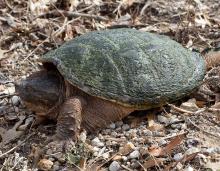Reptiles and Amphibians
Media

Species Types
Scientific Name
Chrysemys dorsalis
Description
The southern painted turtle is small and has a prominent yellow, orange, or red lengthwise stripe down the middle of the upper shell. In Missouri, this aquatic turtle is found only in the Bootheel region.
Media

Species Types
Scientific Name
Plestiodon laticeps
Description
The broad-headed skink is a large, smooth-scaled lizard that lives in the southern two-thirds of Missouri. It is frequently confused with the common five-lined skink, which is smaller.
Media

Species Types
Scientific Name
Chelydra serpentina
Description
A large aquatic turtle with a big pointed head, long thick tail, and small lower shell, the eastern snapping turtle is common throughout the state, anywhere there is permanent water.
Media

Species Types
Scientific Name
Plestiodon obsoletus
Description
The Great Plains skink is a large, tan or light brown lizard with most of the scales edged in black, making it look speckled. These markings may form irregular lines along the back and sides. In Missouri, it's found only in our far western and southwestern counties.
Media

Species Types
Scientific Name
Pantherophis obsoletus
Description
The western ratsnake, a glossy black snake, is one of Missouri’s largest and most familiar snakes. Its size and dark color make it seem imposing, but it is as harmless to humans as it is bad news for rodents.
See Also
About Reptiles and Amphibians in Missouri
Missouri’s herptiles comprise 43 amphibians and 75 reptiles. Amphibians, including salamanders, toads, and frogs, are vertebrate animals that spend at least part of their life cycle in water. They usually have moist skin, lack scales or claws, and are ectothermal (cold-blooded), so they do not produce their own body heat the way birds and mammals do. Reptiles, including turtles, lizards, and snakes, are also vertebrates, and most are ectothermal, but unlike amphibians, reptiles have dry skin with scales, the ones with legs have claws, and they do not have to live part of their lives in water.





















